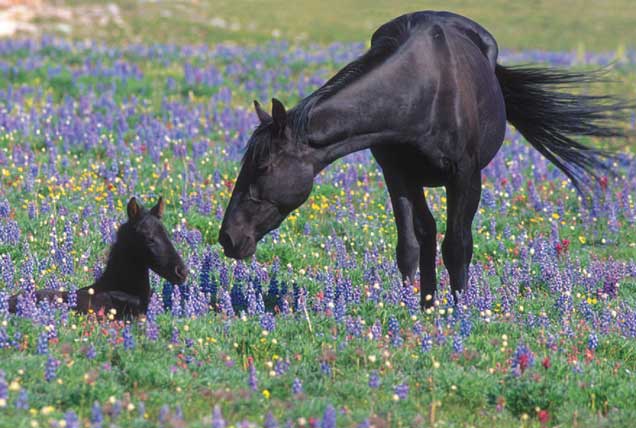
Pryor Mountains Wild Horse Range
Wild horses in the Pryor Mountain Wild Horse Range include a wide variety of colors, such as bay, black, dun, grulla, roam, buckskin and palomino. The wild horse may have dorsal stripes down the back, bi-colored manes and tails, tiger-striped legs and some may have cobwebbing on the face. Adults typically range in size from 13 to 14 hands.
The wild free-roaming horses inhabiting the Pryor Mountain Wild Horse Range most likely descend from a mixture of many domestic breeds. Recent genetic tests concluded that Pryor horses include a higher than average level of ancestry from New World “Spanish” breeds (saddle type horses) and related to European “Spanish” breeds, in addition to other "light racing and riding breeds." Other genetic analyses suggested that the single closest breed to Pryor horses was the Quarter Horse. Some of the Pryor horses carry a rare allele variant Qac that has been traced back to the original New World “Spanish” type horses – Spanish and Portuguese (Iberian) horses that were brought to the Americas. However, all of the genetic markers in these wild horses are found in other horse breeds.
The Pryor Mountain Wild Horse Range is one of only four designated wild horse and burro ranges in the country, which means the area is managed principally, but not exclusively, for wild horses and burros. The Pryor Mountain Wild Horse Range was created by order of the Secretary of the Interior, Stewart L. Udall on September 9, 1968. At the time, the Pryor Mountain Wild Horse Range encompassed 33,600 acres of BLM and National Park Service-managed lands in Montana. In the years since, additional land was added to the Range, including land across state lines in Wyoming. Today, the Pryor Mountain Wild Horse Range comprises of more than 38,000 acres.
Location: The Pryor Mountain Wild Horse Range is in the southeastern portion of Carbon County, Montana, and northern Big Horn County, Wyoming. Approximately 50 miles south of Billings, Montana, and 10 miles north of Lovell Wyoming. Every year, many visitors come to the public lands to enjoy observing these well-known wild horses from a safe distance.
Topography/Vegetation: The area is high in diversity and complex in nature. Elevations range from 3,850 feet to 8,750 feet above sea level. Annual precipitation varies with elevation from 6 inches of precipitation in the lower elevations to upwards of 20 inches in the alpine high elevation. Soils vary in depth from shallow (less than ten inches) to 20-40 inches deep depending on site locations and position on the landscape. Water is considered a limited resource within the Pryor Mountain Wild Horse Range.
Habitat within the Pryor Mountain Wild Horse Range is diverse and ranges from shrub-grass vegetation including big sagebrush, Gardner’s saltbush, black sagebrush, rhizomatous wheatgrasses, Indian ricegrass, needle and thread and bluebunch wheatgrass to communities that include Douglas-fir, lodgepole pine, subalpine fir, limber pine, and juniper.
Plant communities also vary with elevation and precipitation from cold desert shrub to sub-alpine forests and meadows.

